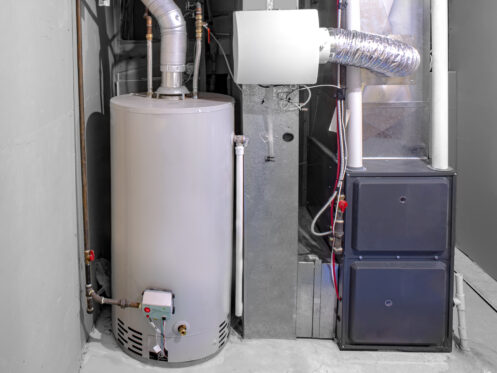You may put off or ignore some plumbing problems until it gets worse. Some minor plumbing issues include slow drains, toilets that don’t flush great, or a lack of consistent hot water. While those problems will eventually need to get fixed, there are some problems you cannot just ignore, like water leaks. A leaking water heater can create many issues in your home. You may deal with a loss of hot water, water damage near the heater, and the possible growth of mold.
While you need to get a water heater repaired as soon as possible, there’s also no need to panic. Learn what steps to take if you suspect a hot water tank leak and follow these steps to avoid any disasters or significant concerns with the hot water tank.
Turn off the Water
To prevent a leak from worsening, you will want to shut off the main water supply to your home. Shutting off the main water supply will prevent the tank from filling with more water. As water leaks from the tank, the automatic controls will attempt to fill the tank again. If you do not know where your home’s main water supply shut-off is, this is an ideal time to learn.
If the water supply shuts off through a traditional valve, turn the valve to the right as tight as possible to shut off the water. If your water supply is operated with lever handles, pull them up so they point straight towards the ceiling. If you cannot access the main water supply to your home, then this is the time to contact a professional plumber. A plumber can shut off the water supply and show you where to access the valves for future emergency water shut-offs.
As you wait for a plumber, reduce any water use in the home so the tank does not use water and try to fill it again.
Turn Off the Hot Water Tank
For another safeguard, you can turn off the tank directly. The process of shutting off a tank depends on your tank type. If you have an electric tank, then you should shut the tank off directly from your fuse box. Most tanks will not have an on/off switch and are directly wired to a fuse box. Look for a label for the hot water heater in your fuse box. If your fuse box does not have labels, you could shut off all power to the home. If you are uncomfortable touching any fuses, call a professional and wait for their arrival.
If you have a gas water heater, you will turn the power directly at the tank. Locate the thermostat on the tank and turn it to the “pilot” setting. This setting will prevent the water tank from operating and help reduce the amount of water leaking.
Find the Source of a Leak
To know where the source of the leak comes from, you can do a visual inspection of the hot water tank. A water heater could have many leak points. One area to look at is the inlet valves on the tank. Due to wear and corrosion, the inlet valve could leak. The water may come directly from the valve and not the leak itself.
To check this, turn the intake valve clockwise to the right to shut it off completely. Take a dry washcloth and rub it around the outer rim of the valve. If the washcloth is wet, then you likely know your leak source. Even when you rely on professionals for repairs, knowing the leak source can help them solve the problem faster and find the source of the leak.
Use another dry washcloth or towel to wipe down the tank itself. While some condensation is normal, you want to wipe away the condensation and check for more leaks.
Like any other step of the process, if you are uncomfortable inspecting the area or your water tank is in a hard-to-reach location, you can wait for a professional to arrive. They have the tools and knowledge to complete a full inspection and get started on the repairs or water heater replacement.
Leak sources may also come from an area that is not as obvious. For example, inlet water pipes could corrode and wear down over time. A small hole can create a big leak and make it look like it comes directly from the water heater instead of the pipes. Even if one leak is detected, a professional plumber will complete a full inspection to ensure you have no other leaks in the area.
Clean Up Excess Water
Before a professional arrives, you can clean up any leaked water. If you leave water, you could delay the repair process, and mold formation could start. If you have a wet/dry vacuum, then you could try to suck up any excess water in the area.
A dry mop could soak up excess water you squeeze into a bucket. Repeat the mop process until a majority of the water is gone. Any water clean-up you can do will help prevent damage and allow repairs to get done quicker.
Contact Professional Plumbers
It is recommended to contact professional plumbers if you feel uncomfortable at any point during this process. Plumbers with emergency services can come to your home right away. If not, you can likely get an appointment within 24 hours and use the steps to help manage any leaks you have. If you turn off the hot water tank and the home’s water valve, you’ll have more time.
Once a plumber arrives, they can complete the steps needed to repair the water tank leak. They will use the same steps provided to get the process started and can explain the process if issues occur in the future. For example, they could figure out which breaker connects to the water heater and provide a label for that fuse. In the future, if you need to shut it off, you’ll have a label to know which to turn off your electric water heater.
If you end up needing a completely new hot water tank, you will have many options, including a tankless water heater or an electric or gas tank water heater. Our NATE-certified technicians will be able to guide you through the water heater selection process so you’ll get the right water heater for your home.
If your hot water tank leaks, do not hesitate to contact us at On Time Experts. We offer 24-hour emergency service, so you do not need to wait until the next business day if a problem has occurred. The quicker you fix a water leak, the less problems you will run into in the future. With more than 30 years of experience, On Time Experts has positioned itself as a full-service HVAC company that offers repair, installation, and maintenance services. Our services include mini-splits, heat pumps, leak detection, and more.

